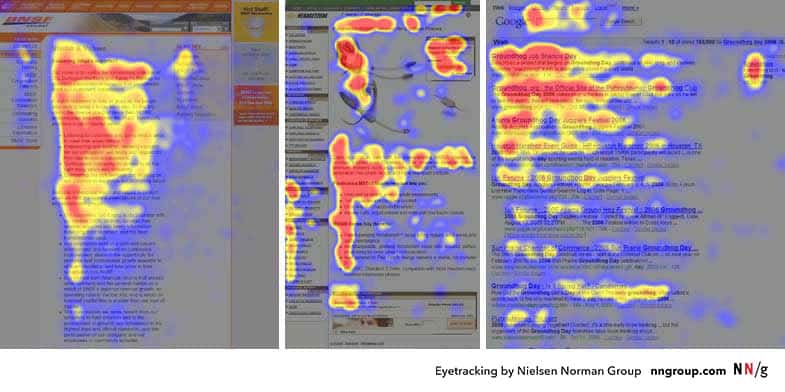People rarely read articles from start to finish.
Instead, they skim.
Specifically, a landmark study by Nielsen Norman Group showed that people skim content in an “F-shaped” pattern.
They start at the top left and read the first line or two.
Then as they scroll down, their eyes skip around more. Reading less and less of the content as they go.
This creates an “F-shaped” pattern, as you can see in these images from the study:

A follow-up study showed that this happens on mobile as well.
You can use this information to optimize your long-form content.
The tips we already covered above will help quite a bit, too: brief introductions, short paragraphs, embedded multimedia, and grease-slide copy.
Those will all go a long way toward keeping people engaged.
In addition, Nielsen Norman Group makes these 3 suggestions for anyone “writing for the web”:
1) Include the most important information at the beginning of your content. Since people read the first few lines more carefully than the rest, use that space to show them they’re in the right place.
For example, begin your article with a quick description of what your article covers. Or the problem it will help your audience solve.
2) Use “information-carrying words” at the start of your paragraphs, subheadings and bullet points.
Readers pay much more attention to the first two words of each paragraph than to the words that come after. So use those first words to identify what the paragraph is about.
That way, skimmers will latch on to the parts of your article that they care about.
For example, say you’re working on a blog post comparing different smartphones.
❌ Bad way to start a paragraph:
“We think that the best Android phone is…” ⬅ This sentence buries the word “Android”, so skimmers might not see it.
✅ Good way to start a paragraph:
“Best Android phone: in our opinion, the…” ⬅ This version puts “Best Android” at the start, making it easy to see what the paragraph is about.
Alternatively, if you have to bury important terms in the middle of a sentence or paragraph, you can use bold font to draw their eyes to it.
3) Use bullet points and numbered lists for important concepts.
People read individual lines more closely than large paragraphs. So putting important information in a list is a good way to highlight it.
(Especially if it comes later in your article, where people are skimming the most aggressively.)
In short, do anything you can to help people get to the most valuable parts of your content.
Interactive content is another way you can do this.
For example, my content marketing examples resource lists over 100 successful examples of content marketing.
It’s a great list. But it’s too long for most people to read through from start to finish.
So I included buttons that let people filter by the exact type of content they’re interested in:

Each visitor can use those filter buttons to create their own unique content experience. And just see what they’re interested in.
A linked table of contents at the start of your article provides similar benefits.
